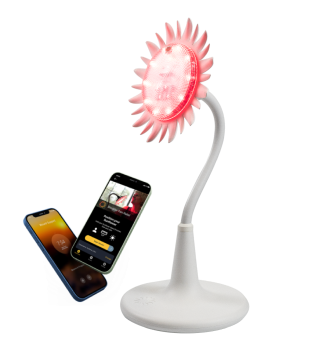
- Shop
- Learn
-
-
- Buy The Sunflower Now
Feel the difference
Get Started with JustLight
Sunflower is the most advanced light therapy available today.

-
- Collaborate
- Blog
- Quiz
- My Account
Free Shipping in the 48 States!
Benefits of Photobiomodulation In the ever-evolving realm of healthcare and wellness, the search for innovative treatments and therapies continues to...
In the ever-evolving realm of healthcare and wellness, the search for innovative treatments and therapies continues to push the boundaries of what is possible. One such emerging modality is photobiomodulation (PBM), a therapy that harnesses specific wavelengths of light to facilitate cellular function and promote tissue repair. Commonly known as low-level laser therapy (LLLT) or red light therapy, PBM is non-invasive, painless, and has shown remarkable potential in various applications ranging from pain relief to cognitive enhancement.
This article delves into the intricate workings of PBM, its mechanisms, the clinical benefits of photobiomodulation, and it’s future prospects. We will explore the science behind PBM, its therapeutic effects on different conditions, and the ongoing research that seeks to expand its applications. This comprehensive exploration aims to provide a thorough understanding of PBM, integrating a wide range of topics and keywords such as clinical studies, light therapy, wound healing, low-level laser therapy, and more.
Photobiomodulation is a therapeutic approach that involves the application of low-intensity light to specific areas of the body. The light, typically in the red or near-infrared spectrum, is absorbed by chromophores within the cells, particularly in the mitochondria. This absorption leads to a series of biological processes that enhance cellular function and energy production.
At the cellular level, benefits of photobiomodulation primarily influences the mitochondrial membrane potential, which is crucial for ATP production. The mitochondrial electron transport chain, a key component in this process, is stimulated by light, leading to increased cellular metabolism and energy production. The therapy has shown positive effects on various cell types, including mesenchymal stem cells and neuronal cells, facilitating their proliferation and function.
The mechanism of action in the benefits of photobiomodulation involves several key elements:
The therapeutic effects of PBM are wide-ranging and supported by numerous clinical studies. These effects can be categorized into several key areas:
The biological effects of the benefits of photobiomodulation are diverse and depend on several factors, including the wavelength and power density of the light, duration of exposure, and the specific condition being treated. The therapy’s mechanisms can be broadly categorized into primary and secondary effects:
PBM also affects the immune system by modulating the activity of immune cells and cytokine production. This can have beneficial effects in treating autoimmune diseases and inflammatory conditions. Additionally, PBM’s impact on the circadian rhythm and sleep patterns has been observed, potentially aiding in the management of sleep disorders.
The clinical applications for the benefits of photobiomodulation are vast, with ongoing research continually expanding its potential uses. Some of the key areas of interest include:
As research progresses, future studies are expected to further elucidate the molecular and cellular mechanisms of PBM, refine treatment protocols, and identify new therapeutic targets. The potential for PBM to be integrated into mainstream medical practice is significant, offering a non-invasive, cost-effective, and versatile treatment option.
While the benefits of photobiomodulation are generally considered safe and well-tolerated, it is essential to understand the potential adverse effects and contraindications. The therapy’s safety profile largely depends on the appropriate selection of parameters, such as wavelength, power output, and exposure duration. Incorrect application can lead to thermal damage or insufficient therapeutic effects.
Before undergoing PBM therapy, it is crucial to consult with a healthcare professional to determine its suitability for your specific needs. This ensures that the therapy is applied safely and effectively, maximizing the benefits of photobiomodulation while minimizing potential risks.
Photobiomodulation represents a promising frontier in the field of medical and wellness therapies. Its wide range of applications, from pain relief and wound healing to cognitive enhancement and skin rejuvenation, underscores its versatility and potential. As research continues to unveil the complexities of the benefits of photobiomodulation’s mechanisms and effects, the therapy is poised to become an integral part of modern healthcare.
Whether you are seeking to manage chronic pain, improve mental clarity, enhance athletic performance, or rejuvenate your skin, PBM offers a non-invasive and scientifically supported option. With ongoing advancements and increasing accessibility, photobiomodulation therapy stands as a beacon of hope for those looking to improve their quality of life through innovative and natural means.
For more information on the benefits of photobiomodulation and how it can support your wellness goals, explore the various resources and consult with healthcare professionals specializing in this cutting-edge therapy. The journey towards optimal health and well-being may very well be illuminated by the gentle glow of photobiomodulation.